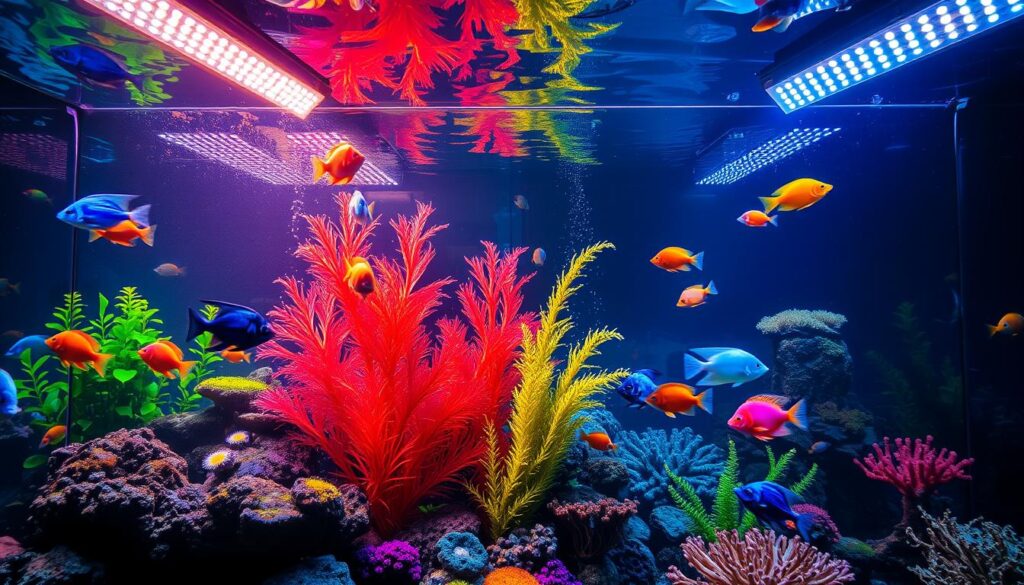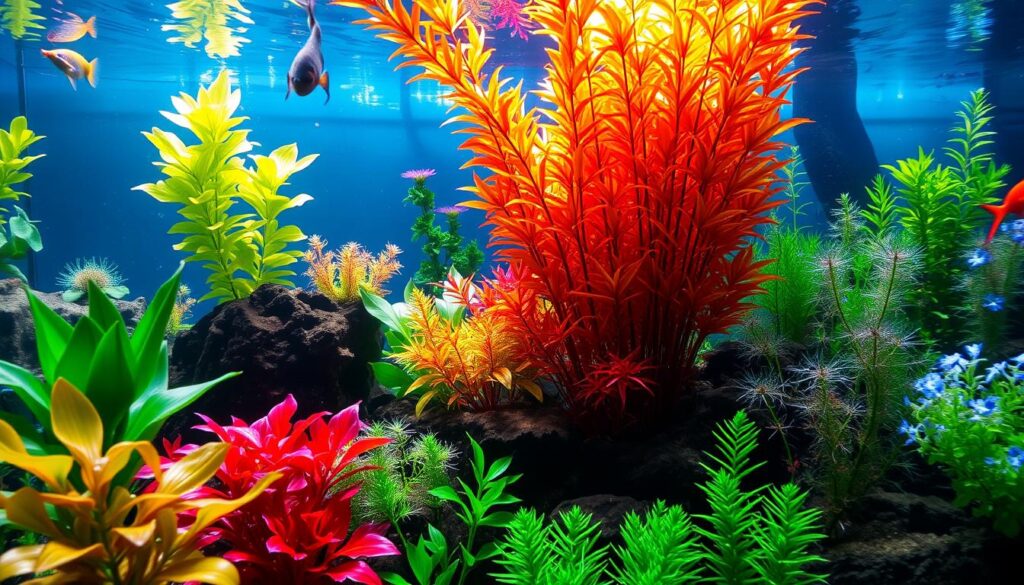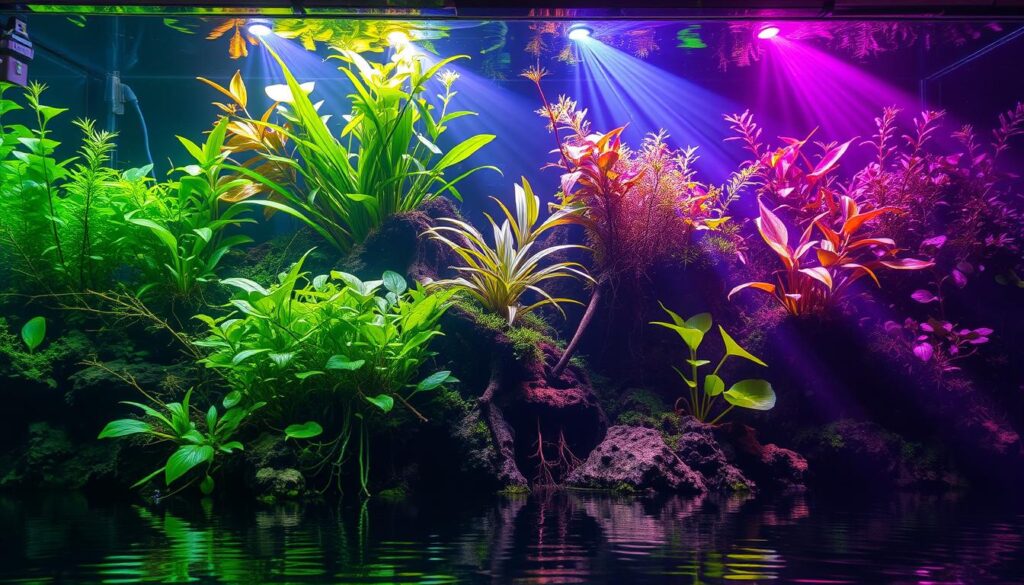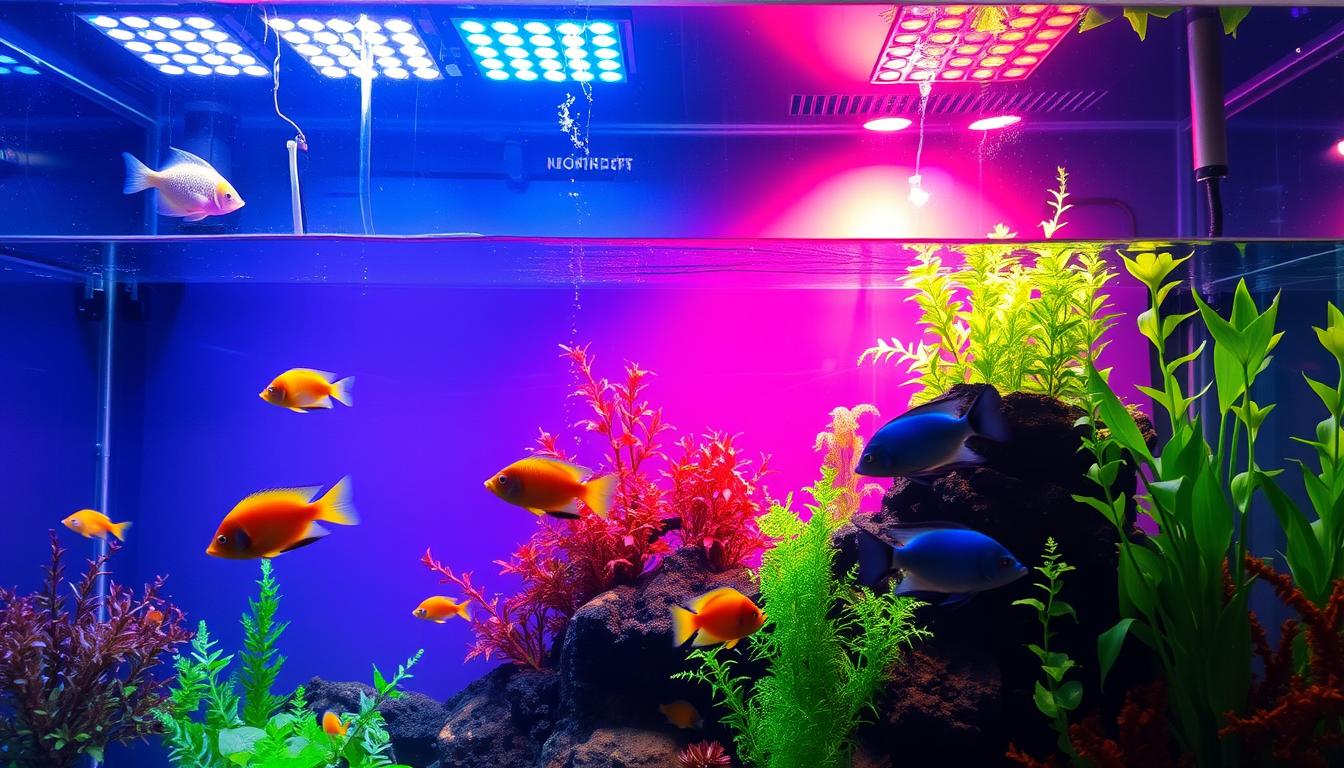Creating a thriving aquatic environment starts with the right lighting. You need to know about the different lighting types, like LED aquarium lighting. The right setup is key for your plants and animals’ health.
Lighting in your aquarium does more than just light it up. It creates a natural space for your plants and animals. LED lighting is popular for its energy savings and ability to adjust colors.
Key Takeaways
- Proper aquarium lighting setup is essential for a thriving aquatic environment
- Understanding the different types of aquarium lighting is crucial for choosing the right option
- LED aquarium lighting is a popular option due to its energy efficiency and customizable spectrum options
- Aquarium lighting setup should mimic the natural habitats of your aquatic plants and animals
- Types of aquarium lighting can affect the health and well-being of your aquatic plants and animals
- A well-designed aquarium lighting setup can enhance the overall aesthetic of your aquarium
Understanding the Basics of Aquarium Lighting
To create a thriving aquatic environment, it’s essential to understand the basics of aquarium lighting. When setting up aquarium lighting, think about its role in aquatic ecosystems. Lighting is key for the health and well-being of your fish and plants.
When picking the best aquarium light fixtures, consider the needs of your fish and plants. Some fish need bright light, while others prefer it dim. Knowing these needs helps you choose the right lighting for your tank.
The role of lighting in aquatic ecosystems
Lighting is crucial in aquatic ecosystems. It supports plant growth and affects fish behavior. In aquariums, artificial lighting mimics sunlight for photosynthesis. By setting up the right lighting, you create a balanced ecosystem for your fish and plants.
Different types of aquarium inhabitants and their lighting needs
Different aquarium inhabitants have unique lighting needs. For example:
- Fish: need a balanced light spectrum for growth and behavior
- Plants: require intense light for photosynthesis and growth
- Corals: need special lighting for growth and color
By considering the lighting needs of your fish and plants, you can pick the best light fixtures. This creates a thriving environment for them.
Types of Aquarium Lighting Systems
Aquarium lighting is key for a healthy aquatic world. There are many lighting systems to choose from. An Aquarium lighting timer helps control light, giving plants the right amount and type of light for growth.
Popular aquarium lighting systems include:
- Fluorescent lighting: A budget-friendly choice for small tanks, it offers basic light for plants.
- LED lighting: Energy-saving and flexible, LED lights come in many spectrum options. They’re great for plant growth and look.
- High-Intensity Discharge (HID) lighting: Best for big tanks, HID lights give strong light but cost more and need to be replaced often.
Think about your plants’ needs and the look you want. The right lighting and an Aquarium lighting timer can make your aquarium beautiful and healthy. It will show off your plants’ beauty.
A good aquarium lighting system is crucial for a lively and healthy aquatic space. Knowing the different lighting options and using an Aquarium lighting timer can elevate your aquarium. You’ll enjoy your plants and fish for many years.
LED Lighting Benefits and Features
LED aquarium lighting is a favorite among aquarists for good reasons. It’s very energy-efficient, which can lower your costs. Plus, it lasts a long time, up to 50,000 hours or more.
LED lighting also lets you customize the spectrum. This means you can adjust the light to help plants grow or make your fish look more vibrant. 
Programming Capabilities
Many LED systems can be programmed. This lets you set up lighting schedules and scenarios. It’s great for choosing the right aquarium lighting for your fish or to mimic daylight.
LED lighting is a top choice for creating a beautiful and healthy aquarium. By looking at energy use, spectrum options, and programming, you can pick the best lighting for your tank.
Complete Guide to Aquarium Lighting Setup
When installing aquarium lighting, think about what your fish need. The aquarium lighting spectrum is key to a healthy home for them. A good lighting setup makes your tank look great and keeps your fish and plants happy.
To start, pick the right lighting for your tank. Think about your tank’s size, the fish and plants you have, and how bright you want it. You can choose from LED, T5, and T8 lights. Always follow the instructions and be careful when installing aquarium lighting.
For a great aquarium lighting spectrum, mix different lights. Use LED lights for main light, and add T5 or T8 for more color and brightness. This mix creates a beautiful and healthy tank that will last for years.
Choosing the Right Light Intensity
When setting up aquarium lighting, picking the right intensity is key. It helps your plants and animals stay healthy. LED aquarium lighting is great because it’s energy-saving and lets you adjust the light spectrum.
To find the best light intensity, think about your plants and animals, tank depth, and the look you want.
Understanding PAR values
PAR (Photosynthetic Active Radiation) values show how much light plants can use for photosynthesis. Each plant needs a certain amount of PAR. So, picking the right plants for your light is crucial. With the right plants and LED aquarium lighting, your aquarium can flourish.
Also, tank depth matters a lot. Deeper tanks need stronger lights to reach everything. By considering these factors and using the right aquarium lighting setup, your aquarium will be stunning and healthy for years.
Color Spectrum and Its Impact
Aquarium lighting is key for a healthy aquatic world. The color spectrum of the light affects plant and fish health and looks. Different light wavelengths boost plant growth, improve colors, and make the aquarium look amazing.
Using an Aquarium lighting timer helps control the light schedule. This ensures plants and fish get the right light at the right time. It’s especially good for plants that need specific light to grow well.
Customizable spectrum options bring many benefits. These include:
- Enhanced plant growth and coloration
- Improved fish health and vitality
- Increased visual appeal of the aquarium
Knowing how color spectrum affects aquarium life helps aquarists create the perfect lighting. They can pick lights with adjustable spectrum and use an Aquarium lighting timer to manage the light schedule.
Mounting and Positioning Your Lights
Mounting and positioning your aquarium lights right is key for a safe and good lighting system. When installing aquarium lighting, think about the best aquarium light fixtures you have and what they need.
To get the best light, adjust the height of your lights. You can use things like suspenders or adjustable arms for this. Also, figuring out how much area your lights cover helps you place them just right.
Height Adjustment Techniques
- Use suspenders to hang lights above the tank
- Adjustable arms for precise positioning
- Consider the type of lighting fixture and its requirements
Coverage Area Calculations
To find the right spot for your lights, measure your tank’s length and width. Then, use a coverage area calculator or check the maker’s guidelines.
By using these tips and picking the best aquarium light fixtures for your tank, you’ll get a safe and good lighting system. Always be careful when installing aquarium lighting to stay safe.
Setting Up Your Lighting Schedule
Choosing the right aquarium lighting is key. A lighting schedule is vital for a healthy aquarium. An aquarium lighting timer makes this easy, ensuring your tank gets the right light at the right time.
Think about your tank’s needs and the natural daylight cycle. Use a timer for a sunrise and sunset effect. This simulates the day’s light changes.
- Increased energy efficiency
- Improved aquatic life health and well-being
- Enhanced visual appeal of the aquarium
With a lighting schedule and an aquarium lighting timer, your tank will thrive. You’ll also enjoy the aquarium’s beauty and wonder.
Lighting Requirements for Live Plants
Aquarium lighting is key for a healthy aquatic ecosystem. Different plants need different light levels. LED lights are popular because they save energy and can be adjusted.
Some plants, like Java Moss and Anubias, do well in low light. Others, such as Amazon Swords and Cryptocorynes, need more light. Knowing what your plants need is crucial for their health and growth. For instance, low-light plants can handle 10-20 lumens per liter, while high-light plants need 40-60 lumens per liter or more.

- Low-light plants: 10-20 lumens per liter
- Medium-light plants: 20-40 lumens per liter
- High-light plants: 40-60 lumens per liter or more
LED lights let you set up a lighting schedule that fits your plants’ needs. This promotes healthy growth and development.
Choosing the right lighting for your plants can make your aquarium a vibrant and thriving space. With the right light, you can see the beauty of your plants. From the bright colors of high-light plants to the soft textures of low-light ones.
Maintenance and Cleaning of Light Fixtures
Keeping your best aquarium light fixtures clean is key for your fish’s health. Regular care helps your lights work well and last longer. When you install aquarium lighting, think about how you’ll keep it clean to avoid problems.
First, turn off the power and let the lights cool. Then, use a soft cloth to remove dust or dirt. For tougher stains, mix water and mild detergent. Use a soft-bristled brush to clean them gently.
- Check your lights often for wear or damage
- Replace any broken parts to avoid more problems
- Keep the area around your tank clean to stop dust from getting on your lights
By following these easy steps, your best aquarium light fixtures will keep your fish happy and healthy. Good installing aquarium lighting and care are essential for a thriving tank.
Common Lighting Problems and Solutions
Setting up an aquarium lighting setup can lead to common problems. These issues can harm your aquatic plants and animals. One big problem is algae growth, often caused by too much light.
LED aquarium lighting can help solve this. It offers a controlled and energy-saving lighting option. But, it’s key to watch the lighting schedule and make changes to stop algae.
Algae Growth Issues
Algae growth is a big problem in aquariums. It can mess up water quality and harm the health of your ecosystem. To stop algae, keep the lighting balanced and avoid too much light.
Light Burn Symptoms
Light burn can hurt your plants and animals if they get too much light. It damages their tissues and can cause health issues. So, it’s important to keep an eye on the light levels and adjust them when needed.
Timer Malfunctions
Timer problems can mess up your aquarium’s lighting schedule. This can harm your ecosystem’s health. To avoid timer issues, check and maintain it regularly to make sure it works right.
Some common fixes for these problems include:
- Monitoring and adjusting the lighting schedule
- Using LED aquarium lighting for better control and energy use
- Regularly checking and maintaining the timer to prevent malfunctions
Advanced Lighting Techniques
When it comes to aquarium lighting for plant growth, there are several advanced techniques to consider. Using multiple light sources can create a more natural environment for your plants. This approach can make your plants look unique and visually appealing.
Color changing lights are another advanced technique. They help simulate the natural day-night cycle. This is great for plants that need a specific light spectrum to thrive. An aquarium lighting timer can automate this, making it easier to care for your plants.

- Increased plant growth and health
- Improved color and vibrancy of plants
- Enhanced visual appeal of the aquarium
But, advanced lighting techniques have some downsides. They can use more energy and cost more. Weighing the benefits and drawbacks helps you decide if these techniques are right for your aquarium.
By using advanced lighting techniques, you can create a unique and thriving environment for your plants, and enhance the overall visual appeal of your aquarium.
Cost Considerations and Energy Efficiency
Getting the right aquarium lighting can be pricey at first. But, think about the long-term savings of using energy-efficient lights like LEDs. LEDs are not only good for the planet but also save you money in the long run.
When looking at the cost of aquarium lighting, consider the upfront cost, upkeep, and ongoing expenses. LEDs are a smart choice because they use less energy and last longer than other lights. Here are some tips to save energy:
- Use LED lighting, which consumes less energy than traditional lighting options
- Adjust the lighting schedule to minimize energy consumption during periods of low activity
- Monitor and maintain your lighting system regularly to ensure optimal performance
By following these tips and picking the right lighting, you can make your aquarium both beautiful and energy-smart.
Initial Investment Analysis
The cost of starting your aquarium lighting can be high. But, remember the long-term savings of energy-efficient options. The right lighting choice can cut down on energy use and lower costs.
Long-term Operating Costs
The ongoing costs of aquarium lighting can add up fast. But, energy-efficient options like LEDs can help keep these costs down. LEDs use less energy, which means lower bills for you.
Maximizing Your Aquarium’s Visual Appeal Through Strategic Lighting
Creating a stunning aquarium is more than picking the right lights. It’s about using light to show off your underwater world’s beauty. By placing and adjusting your lights well, you can make your fish, plants, and rocks look amazing.
Try different light strengths, colors, and spots to get the look you want. Bright lights can make special parts of your tank pop, like colorful fish or plants. Soft lights can make your tank feel calm and natural, turning it into a peaceful spot in your home or office.
Whether you’re starting a new tank or updating an old one, focus on lighting. Learning how to light your tank right can turn it into a beautiful sight that wows everyone.
FAQ
What is the role of lighting in aquatic ecosystems?
Lighting is key in aquatic ecosystems. It gives plants the energy they need to grow. It also affects the health and behavior of fish and other creatures.
What are the different types of aquarium lighting systems?
There are many types of aquarium lights. You can choose from LED, fluorescent, metal halide, and T5 fluorescent. The right choice depends on your tank size, the plants and animals you have, and your budget.
How do I choose the right light intensity for my aquarium?
Choosing the right light intensity is important. Consider your tank’s depth, the needs of your plants, and your fish. Understanding PAR values helps find the best light for your aquarium.
How does the color spectrum of aquarium lighting affect my aquarium?
The color spectrum of your lights affects plant growth and fish color. Different colors help plants and animals in different ways. Choose lights that match your aquarium’s needs.
How do I properly mount and position my aquarium lights?
Mounting and positioning your lights correctly is crucial. Consider the height, coverage area, and safety to avoid electrical hazards.
How do I set up a lighting schedule for my aquarium?
Setting a lighting schedule is vital for a healthy aquarium. Use timers to control light duration and timing. The schedule depends on your aquarium’s inhabitants.
What are the lighting requirements for live plants in an aquarium?
Lighting needs vary for different plants. Some need low light, while others need more. Know your plants’ needs for the right lighting.
How do I maintain and clean my aquarium light fixtures?
Regular maintenance keeps your lights working well. Clean algae, bulbs, and check for damage or electrical issues.
What are some common lighting problems and how can I solve them?
Common issues include algae, light burn, and timer problems. Adjust intensity, schedule, or fix electrical issues to solve these problems.
What are some advanced lighting techniques I can use in my aquarium?
Advanced techniques include using multiple lights and color-changing options. These can create stunning displays, improve plant growth, and meet specific needs of your aquarium’s inhabitants.

